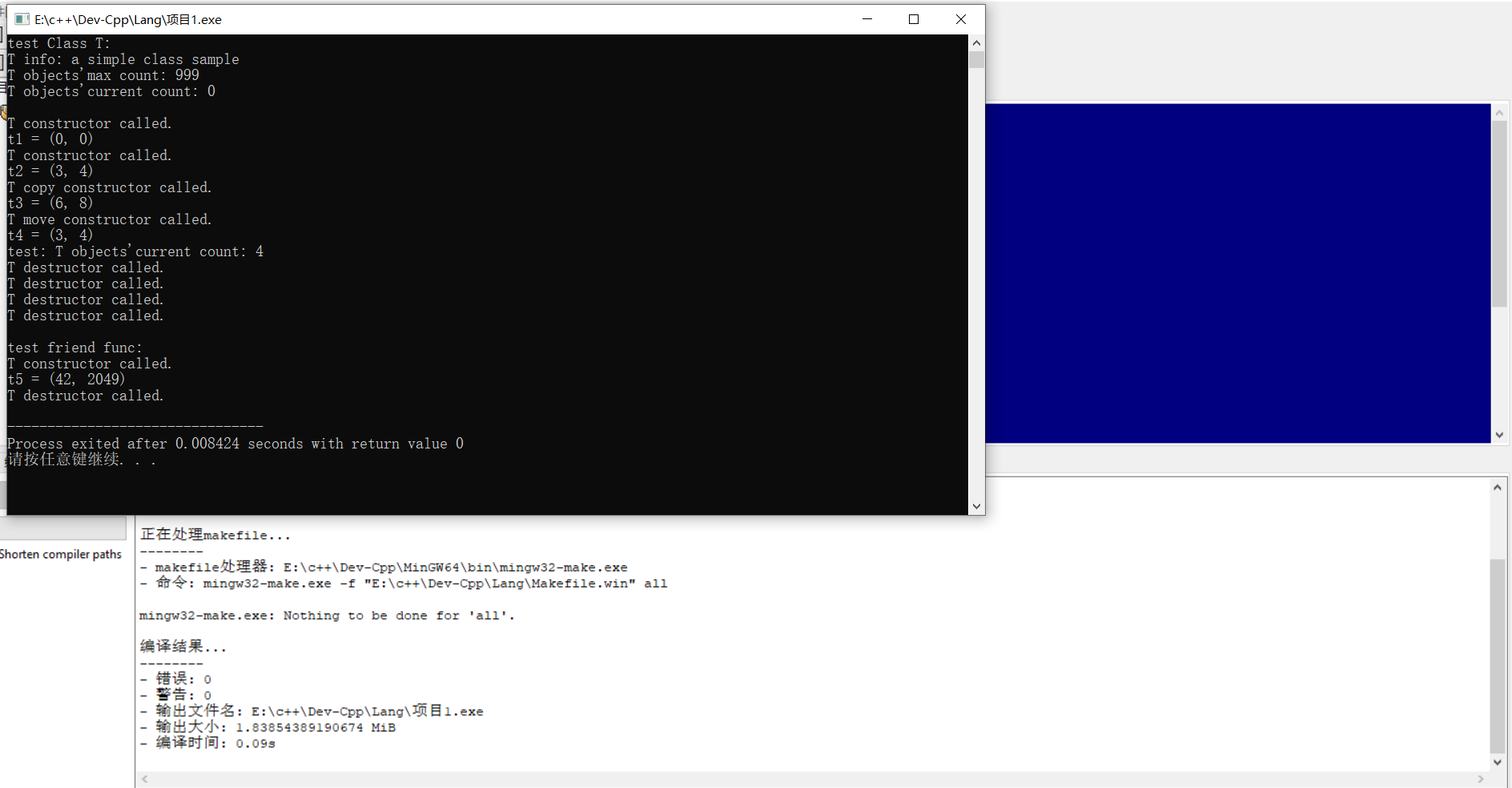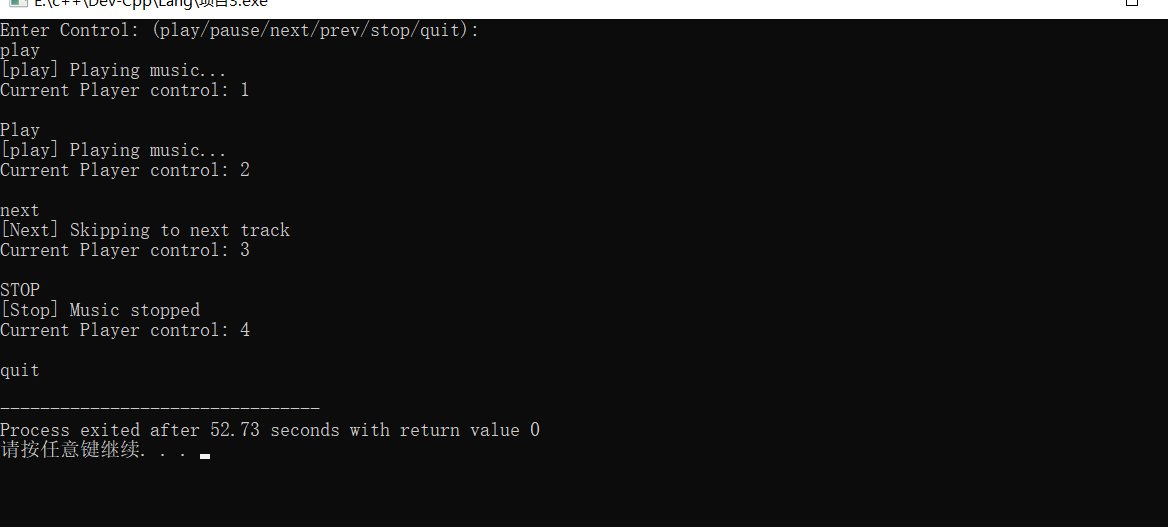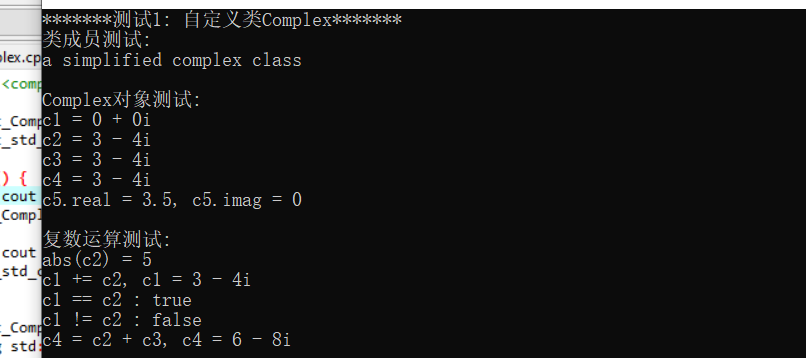实验二
实验内容:
任务一:
代码部分:
T.h:
#pragma once #include <string> // 类T: 声明 class T { // 对象属性、方法 public: T(int x = 0, int y = 0); // 普通构造函数 T(const T &t); // 复制构造函数 T(T &&t); // 移动构造函数 ~T(); // 析构函数 void adjust(int ratio); // 按系数成倍调整数据 void display() const; // 以(m1, m2)形式显示T类对象信息 private: int m1, m2; // 类属性、方法 public: static int get_cnt(); // 显示当前T类对象总数 public: static const std::string doc; // 类T的描述信息 static const int max_cnt; // 类T对象上限 private: static int cnt; // 当前T类对象数目 // 类T友元函数声明 friend void func(); }; // 普通函数声明 void func();
T.cpp:
#include "T.h" #include <iostream> #include <string> // 类T实现 // static成员数据类外初始化 const std::string T::doc{"a simple class sample"}; const int T::max_cnt = 999; int T::cnt = 0; // 类方法 int T::get_cnt() { return cnt; } // 对象方法 T::T(int x, int y): m1{x}, m2{y} { ++cnt; std::cout << "T constructor called.\n"; } T::T(const T &t): m1{t.m1}, m2{t.m2} { ++cnt; std::cout << "T copy constructor called.\n"; } T::T(T &&t): m1{t.m1}, m2{t.m2} { ++cnt; std::cout << "T move constructor called.\n"; } T::~T() { --cnt; std::cout << "T destructor called.\n"; } void T::adjust(int ratio) { m1 *= ratio; m2 *= ratio; } void T::display() const { std::cout << "(" << m1 << ", " << m2 << ")" ; } // 普通函数实现 void func() { T t5(42); t5.m2 = 2049; std::cout << "t5 = "; t5.display(); std::cout << '\n'; }
task1.cpp:
#include "T.h" #include <iostream> void test_T(); int main() { std::cout << "test Class T: \n"; test_T(); std::cout << "\ntest friend func: \n"; func(); } void test_T() { using std::cout; using std::endl; cout << "T info: " << T::doc << endl; cout << "T objects'max count: " << T::max_cnt << endl; cout << "T objects'current count: " << T::get_cnt() << endl << endl; T t1; cout << "t1 = "; t1.display(); cout << endl; T t2(3, 4); cout << "t2 = "; t2.display(); cout << endl; T t3(t2); t3.adjust(2); cout << "t3 = "; t3.display(); cout << endl; T t4(std::move(t2)); cout << "t4 = "; t4.display(); cout << endl; cout << "test: T objects'current count: " << T::get_cnt() << endl; }
结果截图:

问题1:不能继续运行
问题1结果截图:
原因分析:c++中使用任何函数均需要声明,我们删除了普通声明函数在后面的测试中就不可以调用,这个代码提供了接口,是不可以删除的
问题2:
第一个:普通构造函数
功能:创建新对象并初始化成员变量;提供默认参数,支持灵活的对象创建
调用时机:
在test_T中:
T t1; // 调用 T(0, 0) - 使用默认参数T t2(3, 4); // 调用 T(3, 4) - 显式参数
在func()中:
T t5(42); // 调用 T(42, 0) - 部分默认参数(创建全新对象时)
第二个:复制构造函数
功能:创建新对象作为现有对象的副本;执行深拷贝,防止资源共享问题;维护对象计数
调用时机:
在test_T中:
T t3(t2); // 调用 T(const T &t) - 显式复制构造(需要独立副本时)
第三个:移动构造函数
功能:从临时对象或即将销毁的对象"窃取"资源;提高性能,避免不必要的深拷贝;将源对象置于可析构状态
调用时机:
在test_T中:
T t4(std::move(t2)); // 调用 T(T &&t) - 显式移动构造(临时对象,返回值创建)
第四个:析构函数
功能:对象生命周期结束时自动清理资源;减少对象计数;释放动态分配的内存
调用时机:
在前面三个函数调用结束后调用
问题3:不能运行
结果截图:

原因分析:在头文件中进行定义是不对的,静态成员变量需要在类外单独定义,类内定义造成重复定义,意味着重复分配空间,会产生报错
任务二:
代码部分:
Complex.h:
#pragma once #include <string> class Complex { private: double real; double imag; public: // 类属性 static const std::string doc; // 构造函数 Complex(double r = 0.0, double i = 0.0); Complex(const Complex& other); // 对象方法 double get_real() const; double get_imag() const; void add(const Complex& other); // 友元函数声明 friend void output(const Complex& c); friend double abs(const Complex& c); friend Complex add(const Complex& c1, const Complex& c2); friend bool is_equal(const Complex& c1, const Complex& c2); friend bool is_not_equal(const Complex& c1, const Complex& c2); }; // 友元函数声明 void output(const Complex& c); double abs(const Complex& c); Complex add(const Complex& c1, const Complex& c2); bool is_equal(const Complex& c1, const Complex& c2); bool is_not_equal(const Complex& c1, const Complex& c2);
Complex.cpp:
#include "Complex.h" #include <iostream> #include <cmath> // 静态成员初始化 const std::string Complex::doc = "a simplified complex class"; // 构造函数实现 Complex::Complex(double r, double i) : real(r), imag(i) {} Complex::Complex(const Complex& other) : real(other.real), imag(other.imag) {} // 对象方法实现 double Complex::get_real() const { return real; } double Complex::get_imag() const { return imag; } void Complex::add(const Complex& other) { real += other.real; imag += other.imag; } // 友元函数实现 void output(const Complex& c) { std::cout << c.real; if (c.imag >= 0) { std::cout << " + " << c.imag << "i"; } else { std::cout << " - " << -c.imag << "i"; } } double abs(const Complex& c) { return std::sqrt(c.real * c.real + c.imag * c.imag); } Complex add(const Complex& c1, const Complex& c2) { return Complex(c1.real + c2.real, c1.imag + c2.imag); } bool is_equal(const Complex& c1, const Complex& c2) { return c1.real == c2.real && c1.imag == c2.imag; } bool is_not_equal(const Complex& c1, const Complex& c2) { return !is_equal(c1, c2); }
task2:
#include "Complex.h" #include <iostream> #include <iomanip> #include <complex> void test_Complex(); void test_std_complex(); int main() { std::cout << "*******测试1: 自定义类Complex*******\n"; test_Complex(); std::cout << "\n*******测试2: 标准库模板类complex*******\n"; test_std_complex(); } void test_Complex() { using std::cout; using std::endl; using std::boolalpha; cout << "类成员测试: " << endl; cout << Complex::doc << endl << endl; cout << "Complex对象测试: " << endl; Complex c1; Complex c2(3, -4); Complex c3(c2); Complex c4 = c2; const Complex c5(3.5); cout << "c1 = "; output(c1); cout << endl; cout << "c2 = "; output(c2); cout << endl; cout << "c3 = "; output(c3); cout << endl; cout << "c4 = "; output(c4); cout << endl; cout << "c5.real = " << c5.get_real() << ", c5.imag = " << c5.get_imag() << endl << endl; cout << "复数运算测试: " << endl; cout << "abs(c2) = " << abs(c2) << endl; c1.add(c2); cout << "c1 += c2, c1 = "; output(c1); cout << endl; cout << boolalpha; cout << "c1 == c2 : " << is_equal(c1, c2) << endl; cout << "c1 != c2 : " << is_not_equal(c1, c2) << endl; c4 = add(c2, c3); cout << "c4 = c2 + c3, c4 = "; output(c4); cout << endl; } void test_std_complex() { using std::cout; using std::endl; using std::boolalpha; cout << "std::complex<double>对象测试: " << endl; std::complex<double> c1; std::complex<double> c2(3, -4); std::complex<double> c3(c2); std::complex<double> c4 = c2; const std::complex<double> c5(3.5); cout << "c1 = " << c1 << endl; cout << "c2 = " << c2 << endl; cout << "c3 = " << c3 << endl; cout << "c4 = " << c4 << endl; cout << "c5.real = " << c5.real() << ", c5.imag = " << c5.imag() << endl << endl; cout << "复数运算测试: " << endl; cout << "abs(c2) = " << abs(c2) << endl; c1 += c2; cout << "c1 += c2, c1 = " << c1 << endl; cout << boolalpha; cout << "c1 == c2 : " << (c1 == c2)<< endl; cout << "c1 != c2 : " << (c1 != c2) << endl; c4 = c2 + c3; cout << "c4 = c2 + c3, c4 = " << c4 << endl; }
结果截图:

问题1:使用形式上标准库更简洁,更加符合数学表达;函数和运算内在是有关联的,具备数学一致性,语义上等价,功能上对应
问题2:
2-1:是
add(c1, c2):需要读取 c1.real, c1.imag, c2.real, c2.imag
is_equal(c1, c2):需要比较两个对象的所有私有成员
output(c):需要读取输出对象的实部和虚部
abs(c):需要读取对象的实部和虚部进行计算
2-2:标准库 std::complex 没有把 abs 设为友元
2-3:适合友元函数的情况
(1)设计通用库的时候
(2)在考略性能优先的情况
(3)在公共接口不能够实现访问的情况下
(4)当函数需要处理多个对象的私有数据时
问题3:需要将复制构造函数声明为,编译器需要执行隐式转换,通过将复制构造函数设置为explicit,来拒绝隐式转换,从而禁止了拷贝初始化,最终使得“=”失效
explicit Complex(const Complex& other); // 复制构造函数设为 explicit
任务三:
代码部分:
PlayerControl.cpp:
#include "PlayerControl.h" #include <iostream> #include <algorithm> int PlayerControl::total_cnt = 0; PlayerControl::PlayerControl() {} // 待补足 // 1. 将输入字符串转为小写,实现大小写不敏感 // 2. 匹配"play"/"pause"/"next"/"prev"/"stop"并返回对应枚举 // 3. 未匹配的字符串返回ControlType::Unknown // 4. 每次成功调用parse时递增total_cnt ControlType PlayerControl::parse(const std::string& control_str) { // 1. 将输入字符串转为小写,实现大小写不敏感 std::string lower_str = control_str; std::transform(lower_str.begin(), lower_str.end(), lower_str.begin(), [](unsigned char c) { return std::tolower(c); }); // 2. 匹配命令并返回对应枚举 ControlType result; if (lower_str == "play") { result = ControlType::Play; } else if (lower_str == "pause") { result = ControlType::Pause; } else if (lower_str == "next") { result = ControlType::Next; } else if (lower_str == "prev") { result = ControlType::Prev; } else if (lower_str == "stop") { result = ControlType::Stop; } else { result = ControlType::Unknown; } // 4. 每次成功调用parse时递增total_cnt total_cnt++; return result; } void PlayerControl::execute(ControlType cmd) const { switch (cmd) { case ControlType::Play: std::cout << "[play] Playing music...\n"; break; case ControlType::Pause: std::cout << "[Pause] Music paused\n"; break; case ControlType::Next: std::cout << "[Next] Skipping to next track\n"; break; case ControlType::Prev: std::cout << "[Prev] Back to previous track\n"; break; case ControlType::Stop: std::cout << "[Stop] Music stopped\n"; break; default: std::cout << "[Error] unknown control\n"; break; } } int PlayerControl::get_cnt() { return total_cnt; }
PlayerControl.h:
#pragma once #include <string> enum class ControlType {Play, Pause, Next, Prev, Stop, Unknown}; class PlayerControl { public: PlayerControl(); ControlType parse(const std::string& control_str); // 实现std::string --> ControlType转换 void execute(ControlType cmd) const; // 执行控制操作(以打印输出模拟) static int get_cnt(); private: static int total_cnt; };
task3.cpp:
#include "PlayerControl.h" #include <iostream> void test() { PlayerControl controller; std::string control_str; std::cout << "Enter Control: (play/pause/next/prev/stop/quit):\n"; while(std::cin >> control_str) { if(control_str == "quit") break; ControlType cmd = controller.parse(control_str); controller.execute(cmd); std::cout << "Current Player control: " << PlayerControl::get_cnt() << "\n\n"; } } int main() { test(); }
结果截图:

思考:达成使用emoji的效果,可以修改execute函数:
void PlayerControl::execute(ControlType cmd) const { switch (cmd) { case ControlType::Play: std::cout << "🎵 Playing music...\n"; break; case ControlType::Pause: std::cout << "⏸️ Music paused\n"; break; case ControlType::Next: std::cout << "⏭️ Skipping to next track\n"; break; case ControlType::Prev: std::cout << "⏮️ Back to previous track\n"; break; case ControlType::Stop: std::cout << "⏹️ Music stopped\n"; break; default: std::cout << "❌ Unknown control command\n"; break; } }
任务四:
代码部分:
Fraction.cpp:
#include "Fraction.h" #include <iostream> #include <stdexcept> #include <cmath> using namespace std; // 静态成员初始化 const string Fraction::doc = "Fraction类 v 0.01版.\n目前仅支持分数对象的构造、输出、加/减/乘/除运算."; // 辅助函数:求最大公约数 int gcd(int a, int b) { a = abs(a); b = abs(b); while (b != 0) { int temp = b; b = a % b; a = temp; } return a; } // 私有方法:分数化简 void Fraction::simplify() { if (down == 0) { // 分母为0时,设置为0/1(表示无效分数) up = 0; down = 1; return; } // 处理符号:确保分母为正 if (down < 0) { up = -up; down = -down; } // 约分 int common = gcd(up, down); if (common != 0) { up /= common; down /= common; } } // 构造函数 Fraction::Fraction(int numerator, int denominator) : up(numerator), down(denominator) { simplify(); } Fraction::Fraction(const Fraction& other) : up(other.up), down(other.down) {} // 对象方法实现 int Fraction::get_up() const { return up; } int Fraction::get_down() const { return down; } Fraction Fraction::negative() const { return Fraction(-up, down); } // 工具函数实现 Fraction add(const Fraction& f1, const Fraction& f2) { int new_up = f1.get_up() * f2.get_down() + f2.get_up() * f1.get_down(); int new_down = f1.get_down() * f2.get_down(); return Fraction(new_up, new_down); } Fraction sub(const Fraction& f1, const Fraction& f2) { int new_up = f1.get_up() * f2.get_down() - f2.get_up() * f1.get_down(); int new_down = f1.get_down() * f2.get_down(); return Fraction(new_up, new_down); } Fraction mul(const Fraction& f1, const Fraction& f2) { int new_up = f1.get_up() * f2.get_up(); int new_down = f1.get_down() * f2.get_down(); return Fraction(new_up, new_down); }
Fraction.h:
#pragma once #include <string> class Fraction { private: int up; // 分子 int down; // 分母 // 私有方法:分数化简 void simplify(); public: // 类属性 static const std::string doc; // 构造函数 Fraction(int numerator = 0, int denominator = 1); Fraction(const Fraction& other); // 对象方法 int get_up() const; int get_down() const; Fraction negative() const; // 友元函数声明(用于输出) friend void output(const Fraction& f); }; // 工具函数声明 Fraction add(const Fraction& f1, const Fraction& f2); Fraction sub(const Fraction& f1, const Fraction& f2); Fraction mul(const Fraction& f1, const Fraction& f2); Fraction div(const Fraction& f1, const Fraction& f2); void output(const Fraction& f); // 辅助函数 int gcd(int a, int b);
task4.cpp:
#include "Fraction.h" #include <iostream> void test1(); void test2(); int main() { std::cout << "测试1: Fraction类基础功能测试\n"; test1(); std::cout << "\n测试2: 分母为0测试: \n"; test2(); } void test1() { using std::cout; using std::endl; cout << "Fraction类测试: " << endl; cout << Fraction::doc << endl << endl; Fraction f1(5); Fraction f2(3, -4), f3(-18, 12); Fraction f4(f3); cout << "f1 = "; output(f1); cout << endl; cout << "f2 = "; output(f2); cout << endl; cout << "f3 = "; output(f3); cout << endl; cout << "f4 = "; output(f4); cout << endl; const Fraction f5(f4.negative()); cout << "f5 = "; output(f5); cout << endl; cout << "f5.get_up() = " << f5.get_up() << ", f5.get_down() = " << f5.get_down() << endl; cout << "f1 + f2 = "; output(add(f1, f2)); cout << endl; cout << "f1 - f2 = "; output(sub(f1, f2)); cout << endl; cout << "f1 * f2 = "; output(mul(f1, f2)); cout << endl; cout << "f1 / f2 = "; output(div(f1, f2)); cout << endl; cout << "f4 + f5 = "; output(add(f4, f5)); cout << endl; } void test2() { using std::cout; using std::endl; Fraction f6(42, 55), f7(0, 3); cout << "f6 = "; output(f6); cout << endl; cout << "f7 = "; output(f7); cout << endl; cout << "f6 / f7 = "; output(div(f6, f7)); cout << endl; }
结果截图:

问题回答:我选择的是自由函数:
// 自由函数,直接声明在全局作用域 Fraction add(const Fraction& f1, const Fraction& f2); Fraction sub(const Fraction& f1, const Fraction& f2); void output(const Fraction& f);
1. 友元方案
优点:
直接访问私有成员,性能最佳
代码简洁,无需通过getter接口
对于需要访问多个对象私有数据的函数很合适
缺点:
破坏封装性
友元关系难以维护
在头文件中暴露实现细节
2. 静态成员函数方案
优点:
逻辑上与类紧密关联
良好的封装性
调用形式:Fraction::add(f1, f2)
缺点:
静态函数无法访问非静态成员
仍然需要通过getter接口
语义上不如自由函数自然(加法不是类的"静态"特性)
3. 命名空间+自由函数
优点:
避免全局命名空间污染
良好的模块化
清晰的逻辑分组
缺点:
对于简单项目可能过度设计
调用稍显冗长:FractionOps::add(f1, f2)
4. 成员函数方案
优点:
符合面向对象设计
自然的调用语法:f1.add(f2)
缺点:
不适合对称性操作(如 add(f1, f2))
无法支持 f1 + f2 这样的操作符重载风格
对于分数类的数学运算,选择自由函数的原因:
保持了数学运算的对称性
提供了良好的封装性
调用语法自然直观
为将来可能的操作符重载留下空间





 浙公网安备 33010602011771号
浙公网安备 33010602011771号